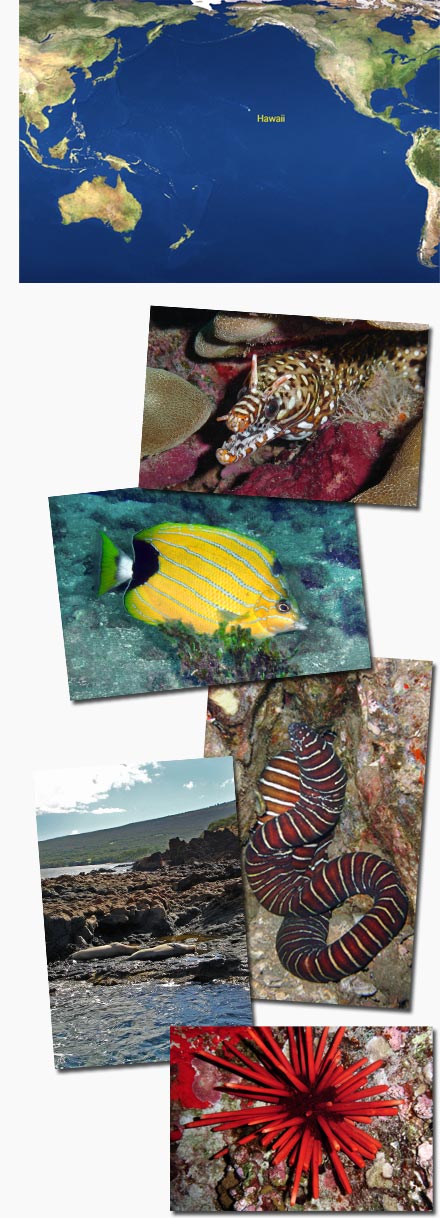
Maui & Hawaiian Marine Life Information
Hawaiian Marine Life Information
A look at the earth from space shows the Hawaiian Islands sitting all alone in the middle of the Pacific, far from other island groups and land masses. That and a cold current which sweeps down from the Bering Strait have determined Hawaii’s unique assemblage of marine life. Set against a volcanic landscape with unusually clear water, Hawaiian diving resembles no other place.
While there are over three thousand species of marine fishes thousands of miles away in Indonesia and New Guinea, the number drops dramatically as one travels eastward. And, according to Dr. Jack Randall, by the time one reaches Hawaii the fish number has been reduced to 1,000. Similar reductions occur in corals and other invertebrates, meaning that Hawaiian waters are host to fewer species than are found in other parts of the world.
Although the main islands of Hawaii are only a few million years old, it is thought that islands have been present in this location for the last seventy million years. As lava poured onto the earth’s crust, the central Pacific plate was ever so slowly inching its way west-northwestwardly at the rate of about four inches a year. A newly formed island would, therefore, be carried away and a new one would form in its place. So Hawaiian marine life has had a place here to congregate and adapt to for a long time.
The ancestors of Hawaii’s marine life all originated someplace else and most arrived here as larvae drifting in ocean currents. Once the first islands had formed, larvae of fish and invertebrates which had hatched in island groups farther west in the Pacific drifted on ocean currents and landed in the islands. A larva is the immature form of an animal after it has hatched from an egg. Its time as a larva is determined by its species and to some extent its environment. Since such a long ocean crossing is required for a larva to reach Hawaii from its nearest island group, many larvae metamorphosed into adult forms without ever having encountered the Hawaiian Islands. Without food or shelter, they did not last long.
Only very rarely did larvae encounter Hawaii in sufficient numbers that, once mature, they could mate and reproduce. Long-lived larvae were more likely to make it to Hawaii and since eel larvae can last up to 30 weeks it is no accident that Hawaii has an abundance of eel species.
Surgeonfish species, also with an extended larval stage, are plentiful as well. On the other hand, snapper and grouper larvae are rather short-lived and any diver who has been to the Caribbean will notice the reduction of these common fish groups here in Hawaii.

Many creatures that did manage to arrive were met with conditions and habitats so foreign that they could not survive. Some, interbreeding for thousands of years, became different enough from their ancestor stock farther west in the Pacific that they are considered different species found only here. This is known as endemism. And Hawaii is the champion when it comes to endemic species. Roughly 20% of the fish species you see on a dive here are found only here. Some, such as the Belted Wrasse, are so close in appearance to their Indo-Pacific relatives that it is difficult for the average non-fish scientist to tell them apart. Others are so very different that they lack existing relatives completely. In the case of Hawaii’s endemic Bluestripe Butterflyfish (Chaetodon fremblii) its only probable relative is off the eastern coast of Africa.
The unique variety of animals that were able to colonize Hawaii meant that some animals had fewer predators or fewer competitors than in their ancestral location. For some species, this meant a more friendly environment, and so they were able to increase in numbers. This is the case with the red pencil urchin and the yellow tang, among others. Both of these species are more numerous in Hawaii because conditions here allow them to thrive in ways that they do not elsewhere in the world.
Hawaii’s isolation kept humans from colonizing the islands for a long time as well. This distance from populous areas has probably been the reason Hawaii’s green sea turtle population is in better shape than its Caribbean and Mediterranean counterparts. Not only was a smaller populace hunting turtles in the past, but the uninhabited islands and atolls of the northwest Hawaiian chain provide undisturbed mating and nesting grounds for the turtles as well as an endemic Hawaiian monk seal. Through the protective efforts of individuals and state and federal governments, sea turtle populations have been increasing in Hawaii for years.
Hawaiian marine life offers divers the opportunity to see the results of a unique evolutionary occurrence against a volcanic landscape with excellent visibility. From mammoth whale sharks to abundant sea turtles to gorgeous nudibranchs Hawaii has much to offer.
